How to Use the SEARCH Function in Excel: Usabilities, Examples, and Writing Steps
Home >> Excel Tutorials from Compute Expert >> Excel Formulas List >> How to Use the SEARCH Function in Excel: Usabilities, Examples, and Writing Steps
In this tutorial, you will learn how to use the SEARCH function in excel completely.
When working with data in excel (especially texts), we may sometimes need to know the position of a part in our data. One of the things you can use to help you get this information fast is the excel SEARCH function.
Want to know more about SEARCH and how to use it properly to help you in excel? Read this tutorial until its last part!
Disclaimer: This post may contain affiliate links from which we earn commission from qualifying purchases/actions at no additional cost for you. Learn more
Want to work faster and easier in Excel? Install and use Excel add-ins! Read this article to know the best Excel add-ins to use according to us!
Table of Contents:
- What is the SEARCH function in excel?
- SEARCH usability
- SEARCH result
- Excel version from which we can start using SEARCH
- The way to write it and its inputs
- Example of its usage and result
- Writing steps
- Case-sensitive SEARCH: FIND
- SEARCH with wildcard characters
- Know if a cell contains a specific text: ISNUMBER SEARCH/IF ISNUMBER SEARCH
- Exercise
- Additional note
What is the SEARCH Function in Excel?
SEARCH is an excel function that helps you to find the position of a data part in your data (usually text). SEARCH isn’t case-sensitive and it recognizes wildcard characters in its input.SEARCH Usability
You can use SEARCH to get the position of a data part in your data fast and easily.SEARCH Result
The SEARCH result is a number that represents the position of a data part in your data.Excel Version from Which We Can Start Using SEARCH
We can start using SEARCH in excel since excel 2003.The Way to Write It and Its Inputs
Here is the general writing form of SEARCH in excel.
= SEARCH ( data_part_to_find , data , [ starting_position_to_find_the_data_part ] )
And here is a bit explanation for the inputs you need to give while using SEARCH in excel.
- data_part_to_find = the part of data you want to find the position of
- data = the data from which you want to find the position of its part
- [starting_position_to_find_the_data_part] = optional. The starting position in your data from where you want to find the data part. If you omit this, then SEARCH will try to find the data part from position 1 (the most left position in the data)
Example of Its Usage and Result
Here is an implementation example of SEARCH in excel.
In the example, we want to find a data part position in the data that we have. We use SEARCH to help us find it.
As we discussed previously, we just need to input the data part and the data itself when we use SEARCH. Input the starting position where you want to start finding the data part position too if it helps you.
By writing our SEARCH like that, we get all the data part positions we need in our example! As you can see in the second row there, however, SEARCH isn’t case-sensitive in its data part finding process. Consider this nature when you want to find your data part position by using this SEARCH formula.
Writing Steps
Confused when you need to write SEARCH in your excel cell? Take a look at the SEARCH writing steps below to help you do it!-
Type an equal sign ( = ) in the cell where you want to put the position of your data part
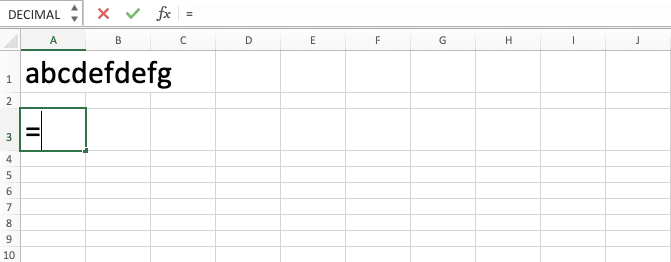
-
Type SEARCH (can be with large and small letters) and an open bracket sign after =
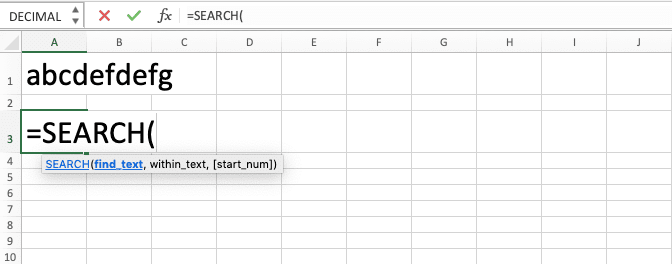
-
Input the data part you want to find the position of in your data. Then, type a comma sign ( , )
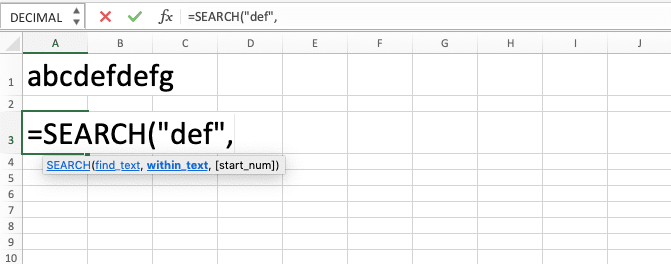
-
Input the data from where you want to find the position of the data part you inputted earlier
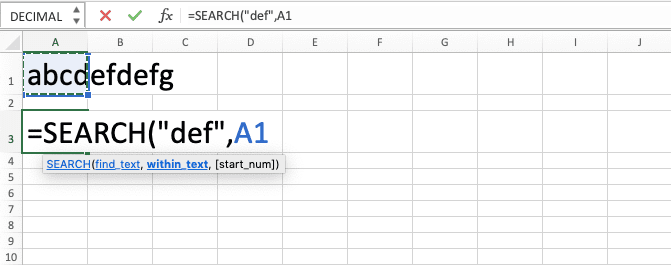
-
Optional: Type a comma sign. Next, input the number which represents the starting position from where you want to find your data part inside your data. If you omit this input, SEARCH will start the finding process at position 1 (the most left position in the data)
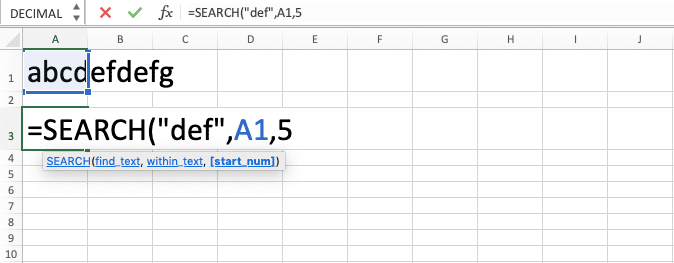
-
Type a close bracket sign
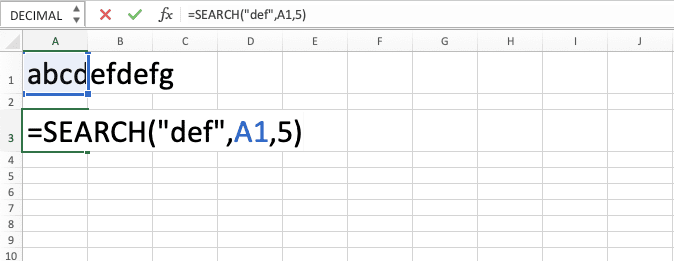
- Press Enter
-
Done!
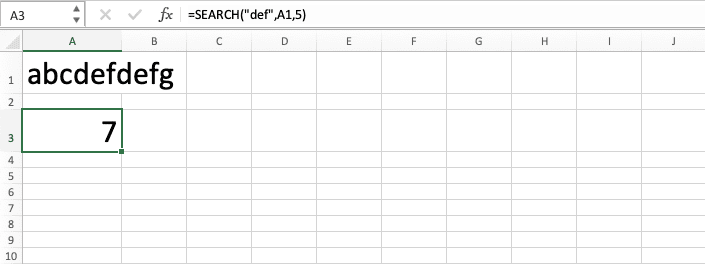
Case-Sensitive SEARCH: FIND
Want to find the position of your data part in a case-sensitive manner? You may need to do that since case sensitivity may get you the correct position of the data part you want.If you need to be case-sensitive, then you need to use FIND instead of SEARCH. FIND is an excel formula that helps you to find the position of a data part too in your data. However, FIND is case-sensitive, unlike SEARCH.
Here is the general writing form of FIND in excel.
= FIND ( data_part_to_find , data , [ starting_position_to_find_the_data_part ] )
Similar writing form as SEARCH, right? If you have understood how to write SEARCH previously, you should have no trouble when you write FIND.
Here is the implementation example of FIND in excel.

As you can see here, FIND is case-sensitive when trying to find the data part we input into it. If a data part has different letter cases, even if its content is similar, FIND will ignore it.
This is different from SEARCH which isn’t case-sensitive. Here are the SEARCH results if we try to implement it to the data set above.

As SEARCH isn’t case-sensitive, it will take the data part position by looking at the content only.
To find a data part position in your data correctly, consider the best formula for you to use: SEARCH or FIND!
SEARCH with Wildcard Characters
Besides their case sensitivity difference, there is also another important difference we should note when we want to use SEARCH/FIND. That difference is SEARCH can process wildcard characters while FIND cannot.If we still don’t know several characters that our data part input has, wildcard characters can help us with that. Wildcard characters are the characters that represent one/several of any characters in our excel formula.
There are two wildcard characters we often use in excel.
- * = represents any character with any amount
- ? = represent any one character
We can use them in SEARCH in our data part position input. Use the one that best suits your needs whenever you want to find your data part position!
Here is an implementation example of the wildcard characters in action in our SEARCH formula.

Whenever you need something to represent characters you don’t know in your SEARCH data part input, utilize the wildcard characters
Know if a Cell Contains a Specific Text: ISNUMBER SEARCH/IF ISNUMBER SEARCH
Want to know whether your cell contains specific text or not in excel? You can also use SEARCH to get that information by combining it with ISNUMBER and IF.Combine SEARCH with ISNUMBER only if you want to get the identification result in TRUE or FALSE (TRUE for if the cell contains the text and FALSE for if the cell doesn’t). If you want a special identification mark instead, however, then you can combine IF too with them.
Here is the general writing form for the ISNUMBER SEARCH and the IF ISNUMBER SEARCH formulas in excel.
ISNUMBER SEARCH
= ISNUMBER ( SEARCH ( data_part_to_find , data ) )
IF ISNUMBER SEARCH
= IF ( ISNUMBER ( SEARCH ( data_part_to_find , data ) ) , “Yes” , “No” )
Write your SEARCH formula inside ISNUMBER. You don’t need to input a starting position to SEARCH here since we just use it to ensure a text’s existence. Input the ISNUMBER and SEARCH in your IF logic condition part if you combine them with IF too.
In this IF ISNUMBER SEARCH writing form, we have “Yes” and “No” as our IF true and false results. You can obviously change them into other things depending on your preference.
Here is an implementation example of ISNUMBER SEARCH and IF ISNUMBER SEARCH in excel.
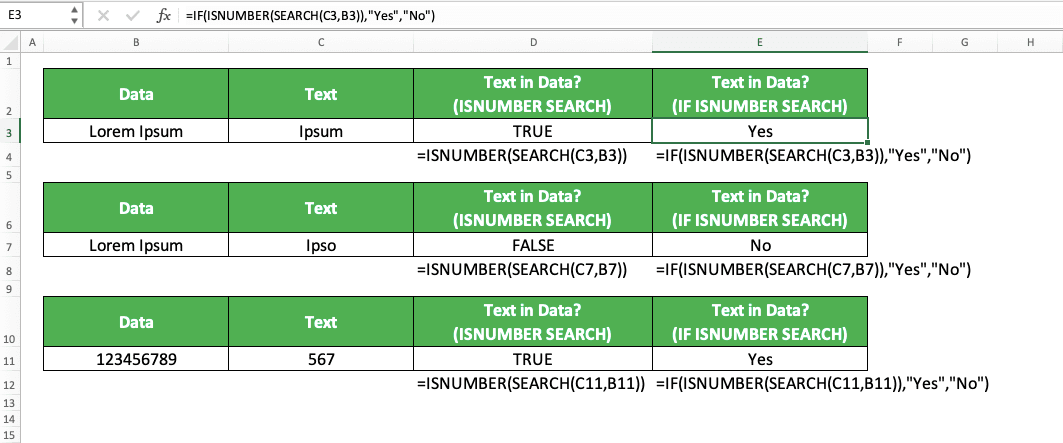
As you can see there, our formulas combinations can identify whether a specific text exists in a cell. If we combine ISNUMBER and SEARCH only, we will get a TRUE or FALSE result. If we combine IF, ISNUMBER, and SEARCH, we can get an identification mark according to our preference.
Exercise
After you have understood how to use SEARCH in excel completely, let’s deepen your understanding by doing the following exercise.Download the exercise file and answer all of the questions. Download the answer key file if you have done the exercise and want to check your answers. Or probably if you are confused when you want to answer the questions!
Link to the exercise file:
Download here
Questions
Use SEARCH to answer all the questions below!- What is the number that represents the position of the letter e?
- What is the number that represents the position of “John”?
- What is the number that represents the position of “-HIXY”? Use a wildcard character to replace the “-“ symbol in your SEARCH input!
Link to the answer key file:
Download here
Additional Note
If you need to input a * or ? symbol literally in SEARCH, use a tilde symbol (~) before you input the symbol.Related tutorials you should learn too:














